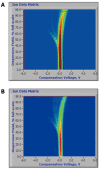Diagnosing gastrointestinal illnesses using fecal headspace volatile organic compounds
- PMID: 26819529
- PMCID: PMC4721995
- DOI: 10.3748/wjg.v22.i4.1639
Diagnosing gastrointestinal illnesses using fecal headspace volatile organic compounds
Abstract
Volatile organic compounds (VOCs) emitted from stool are the components of the smell of stool representing the end products of microbial activity and metabolism that can be used to diagnose disease. Despite the abundance of hydrogen, carbon dioxide, and methane that have already been identified in human flatus, the small portion of trace gases making up the VOCs emitted from stool include organic acids, alcohols, esters, heterocyclic compounds, aldehydes, ketones, and alkanes, among others. These are the gases that vary among individuals in sickness and in health, in dietary changes, and in gut microbial activity. Electronic nose devices are analytical and pattern recognition platforms that can utilize mass spectrometry or electrochemical sensors to detect these VOCs in gas samples. When paired with machine-learning and pattern recognition algorithms, this can identify patterns of VOCs, and thus patterns of smell, that can be used to identify disease states. In this review, we provide a clinical background of VOC identification, electronic nose development, and review gastroenterology applications toward diagnosing disease by the volatile headspace analysis of stool.
Keywords: Electronic nose; Feces; Mass spectrometry; Odors; Volatile organic compounds.
Figures



Similar articles
-
The Impact of Storage Conditions on Stool Smellprints as Assessed by an Electronic Nose.ACS Sens. 2025 Feb 28;10(2):689-698. doi: 10.1021/acssensors.4c01807. Epub 2025 Jan 16. ACS Sens. 2025. PMID: 39817811
-
A machine learning-based electronic nose for detecting neonatal sepsis: Analysis of volatile organic compound biomarkers in fecal samples.Clin Chim Acta. 2025 Jan 15;565:119974. doi: 10.1016/j.cca.2024.119974. Epub 2024 Sep 24. Clin Chim Acta. 2025. PMID: 39326694
-
The Assessment of Fecal Volatile Organic Compounds in Healthy Infants: Electronic Nose Device Predicts Patient Demographics and Microbial Enterotype.J Surg Res. 2020 Oct;254:340-347. doi: 10.1016/j.jss.2020.05.010. Epub 2020 Jun 8. J Surg Res. 2020. PMID: 32526503 Free PMC article.
-
Review article: next generation diagnostic modalities in gastroenterology--gas phase volatile compound biomarker detection.Aliment Pharmacol Ther. 2014 Apr;39(8):780-9. doi: 10.1111/apt.12657. Epub 2014 Feb 20. Aliment Pharmacol Ther. 2014. PMID: 24612215 Review.
-
Volatile organic compounds as diagnostic biomarkers in gastrointestinal and liver diseases.J Gastrointestin Liver Dis. 2009 Sep;18(3):337-43. J Gastrointestin Liver Dis. 2009. PMID: 19795029 Review.
Cited by
-
Gas Chromatography-Sensor System Aids Diagnosis of Inflammatory Bowel Disease, and Separates Crohn's from Ulcerative Colitis, in Children.Sensors (Basel). 2024 Aug 5;24(15):5079. doi: 10.3390/s24155079. Sensors (Basel). 2024. PMID: 39124126 Free PMC article.
-
Effects of Sampling Conditions and Environmental Factors on Fecal Volatile Organic Compound Analysis by an Electronic Nose Device.Sensors (Basel). 2016 Nov 23;16(11):1967. doi: 10.3390/s16111967. Sensors (Basel). 2016. PMID: 27886068 Free PMC article.
-
Wake up and smell the coffee: The potential of faecal volatile organic compounds in paediatric inflammatory bowel disease.United European Gastroenterol J. 2024 Jul;12(6):660-661. doi: 10.1002/ueg2.12618. Epub 2024 Jun 18. United European Gastroenterol J. 2024. PMID: 38888204 Free PMC article. No abstract available.
-
Smell - Adding a New Dimension to Urinalysis.Biosensors (Basel). 2020 May 5;10(5):48. doi: 10.3390/bios10050048. Biosensors (Basel). 2020. PMID: 32380781 Free PMC article.
-
Non-target GC-MS analyses of fecal VOCs in NASH-hepatocellular carcinoma model STAM mice.Sci Rep. 2023 Jun 1;13(1):8924. doi: 10.1038/s41598-023-36091-7. Sci Rep. 2023. PMID: 37264108 Free PMC article.
References
-
- Hippocrates , Potter P. Hippocrates, Vol. 9: Coan Prenotions- Anatomical and Minor Clinical Writings. Massachusetts: Harvard University Press; 2010. p. 265.
-
- Buljubasic F, Buchbauer G. The scent of human diseases: A review on specific volatile organic compounds as diagnostic biomarkers. Flavour Fragr J. 2015;30:5–25.
-
- Williams H, Pembroke A. Sniffer dogs in the melanoma clinic? Lancet. 1989;1:734. - PubMed
Publication types
MeSH terms
Substances
Grants and funding
LinkOut - more resources
Full Text Sources
Other Literature Sources
Medical

